How to Choose a Generator for Your Home
6 minute readHow to choose the right generator for your Texas home
Home > Blog > How to Protect Your Home from a Power Surge
4 minute read • Last update May 2024

Power surges are sudden, temporary increases in voltage significantly above the normal flow of electricity. In standard North American homes, the typical voltage for electricity is 120 volts. If the voltage exceeds this level, even for just a millisecond, it can be considered a power surge.
Power surges can damage your home in several ways, primarily by harming electrical appliances and possibly causing electrical fires.

Power surges can be caused by a variety of natural events and human-made issues. Some of the most common causes of power surges are:
There are several ways to tell if a power surge has occurred in your home.
Two of the most common and effective ways to protect your home from a power surge are to install a whole house surge protector and to utilize power strips with surge protection features.
Whole home surge protectors are installed on your home’s service panel or breaker box to prevent surges from entering and impacting your house’s electrical systems. To ensure they function properly, have the equipment installed by a professional and qualified electrician.
Another option is to utilize power strips that can protect your devices from surges. These surge protectors plug directly into your electrical outlets, and you plug the devices into the power strip. They are capable of preventing power surges from impacting and damaging your appliances and electronics by absorbing or redirecting the excess voltage.
Homeowners can also protect their homes from power surges by manually unplugging devices during storms where a lightning strike may occur, by scheduling regular inspections of your electrical system by a professional, and investing in high quality appliances and electronics.
If you’ve experienced a power surge, you may be wondering what to do next.
If you’re thinking about upgrading your home’s surge protection technology, you may also be interested in upgrading your electricity provider.
BKV Energy offers simple and affordable fixed rate electric plans that can save Texans up to $800 or more each year on their bills.
Enter your zip code to explore rates in your area.
Graham Lumley, Digital Marketing Manager at BKV Energy, leads digital and traditional marketing strategies, focusing on educating Texans about the state's deregulated energy market. With over 8 years of marketing experience, he creates content to help consumers understand and save on their energy bills, bringing a fresh and dynamic approach to the industry.

How to choose the right generator for your Texas home

Energy Saving Tips Home Improvement
Choosing the right energy-efficient door can help Texas homeowners reduce cooling costs and improve home comfort year-round.
Get $50 off your electric bill!
Use code BKVEJOINUS50
Enter your zip code to shop BKV Energy's affordable, fixed-rate Texas electricity plans. Use the promo code for $50 off your electric bill.